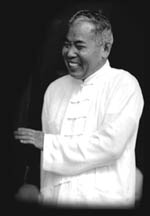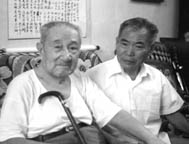WELCOME
- SUSAN A MATTHEWS HOME
- SHANTI SCHOOL HOME PAGE
- STUDY GUIDE
- SPIRAL ANATOMY™
- BRAIN WORKSHOP™ TRAINING
- GEORGE XU HOME PAGE
- CONTACT US
Website Design: Susan Matthews
© 2003-2025
all rights reserved
No part of this website may be reproduced without expressed permission.
Following the Disappearing Footprints of Yesterday
by J. Reynolds Nelson
A great article about Wu Style Grandmaster Wang Hao Da published in Qi Magazine Issue 48: Following the disappearing footprints of yesterday
 |
In 1923 Shanghai was one of the outstanding cosmopolitan centres of our planet. In addition to the transient panorama of the time, including leading politicians, socialites, bold criminals, and imperialistic carpetbaggers, it was a great centre of Martial Arts. Regularly occasioned by the great Boxers of the day like Chen Fake, Yang Cheng Fu, Wu Chien Chieh, among others, there also lived a young Daoist named Ma Yueh Liang. It was in this year that Wang Hao Da was thrust headlong into the doomed city. Before he was a teenager he was already pressed into hard labour and by the time the Japanese arrived to occupy the city he was used to surviving 20-hour workdays on two bowls of rice. Before he was forty his body was racked with ruin, his health on the verge of collapse. |
During the Cultural Revolution, when it was a crime to associate with named criminals, he ignored the rule of law and begged Master Ma to take him on as a student to preserve his life. While the majority of Shanghai culture was bent on self-destruction, Wang Hao Da spent his days secretly practicing the Art he learned behind closed doors from one of Chinas’ greatest Masters. Unable to work any longer, he devoted every moment observing, listening, and practicing with his great teacher. One of only three students Master Ma dared to accept during these dark years, Wang Hao Da had exclusive access to, arguably, one of the paramount resources of the century. By the time the Cultural Revolution ended and Ma Yueh Liang was allowed to emerge from self-criticism, Wang Hao Da had learned many of the secrets of the Master.
Day after day he would go to the local park and cross hands with all who would push him. For years he searched to understand the principles he had learnt by feeling the bodies and centre of others. He invested in loss, for time and again his soft touch was overwhelmed by forceful and hard artists bent on the path of strength and power. His character was undiminished, for daily his health improved. A small man in any case, he had never expected to overwhelm those often twice his size. His search was for the true internal power his teacher had shown and assured him could overcome any and fulfill his need to recover. Finally, twelve years ago, after 33 years of practice and while his teacher still lived, he discovered within him the bloom of his teacher’s seed. Standing on the spot in any park in Shanghai, Short leg Wang as he is affectionately known, will take on and defeat all comers, enigmatic smile on his face, heart happy.
|
This May he will travel to San Francisco for his fourth year to train western students in the life-giving and empowering Art he was so fortunate to comprehend. Unlike so many, who have all the wealth and power in the world yet seek more and are never satisfied with their lot, Wang Hao Da is a happy and fulfilled man, humble to his core and genuinely desirous to pass on those precious secrets. While only now becoming well known in the west, Grandmaster Wang is widely acknowledged by his contemporaries in Shanghai and has been shown the highest honours of his city’s Martial Arts community. Last September we had the great good fortune to introduce him to our community here in Great Britain, where he shall return in September 2000. Thanks to Master Xu Guo Ming, who introduced us and translated the words and meanings of the Grandmaster, we are able to report here the essence of his message. |
Correct central equilibrium {Zhong Ding} is the basis for everything else in Taijiquan. One must focus with their complete intention {Yi} to differentiate that which is external and separate from one’s centre. The centre is the key; it must remain straight and hidden, concentrated, deep inside the body constantly changing, spiraling into the earth for the most part. One must gather all the Qi {energy} to your centre. It is this structure that is the basis for internal power {Nei Jing} or Zhong Ding Jing, and essential for good health and longevity. The Dantien {lower abdomen} is alive! Not only does the Dantien push down inside the open hips but also it turns, spirals, bounces, and shoots; inside the structure is always full, always condensed. When you play the Taiji form you are performing the interaction of your Zhong Ding and Dantien. This hidden internal play moves the outside, not necessarily the entire body like a single lump of wood, rather by gathering everything to your centre, your outside body follows the direction of this internal command. It is because your inside works so intensively that you receive the health benefit of Taiji. If one only works externally and has strong skin and muscles but weak organs, vessels, and bones, then the outside may thrive while internally you are dying.
Spiritual concentration is crucial. Your Yi must be strong, focused, pure, intent, gathering, confident, and sensitive. It is the Yi/Qi that work together to develop Nei Jing, not ones outer display of strength, {Li} that epitomizes all that is Taiji. The Yi is used at first to search internally for correct alignment of the Zhong Ding, the Dantien and its range of motion, to differentiate between open and closed, empty and full, extension, rooting, and connections. As one develops this inner sensitivity the next goal is to practice control over these basic principles in the correct way, so that the body remains straight, connected, rooted, full, and spirals throughout the Taiji form. Yi is accountable for the gathering of the Qi, and works in harmony with it, in order for these principles to be applied. Yi is responsible for relaxing the external body, the muscle; for storing the Qi one develops in practice, for making smaller circles and spirals, for condensing movement to small frame, and eventually to no visible movement in order to develop Nei Jing.
Rooting three feet into the earth has a double meaning. First one must make their Yi/Qi thick and sink heavy into the earth at least three feet down. Secondly one’s Zhong Ding, like the tailbone, is a third leg and its foot must be buried into the earth.
Rooting is a very important concept in Taiji. Your root must always be deeper than your opponent. In order to dig them out you must be below them. The Dantien and Zhong Ding must be structurally sound and without correct root this is impossible. However you must not be rigid! You must be light and agile, changeable, quiet yet quick. You must learn to balance your power downwards and upwards; the bottom is heavy, the top is light; connected. In order to root you must have a good understanding of the hips. The hips are very complex, the inside hip {Kua} must be free to open and close, spiral into the earth. The outside hip must be strong and flexible to grip the earth, and the sacrum and tailbone must be straight and changeable. The bowl of the pelvis, like a wok or cauldron must be round and accommodate the Dantien. When you develop an understanding of how these things work in harmony your rooting will become more profound.
|
Learning to connect is fundamental, yet I have been surprised how western students have missed out on this basic principle. Gripping the earth, whole body structure power {Gatsa Jing} cannot be neglected. Just because one concentrates to the centre, develops correct Zhong Ding, the outside body is not tofu. Extension is the basis of connection, yet many people wave their arms around in an unconnected and disharmonious method. As a minimum requirement the three external harmonies should be observed, the arms and legs emerge from the spine and work as such. Yes I say work the internal exclusively, deep internal soft movement like water, full like an air bag, but not at the expense of basic connection – extension. |
Silk reeling power {Chan Si Jing} is a significant component of the Wu style. Every movement must be a spiral. One spirals into the earth and one spirals away from the Zhong Ding for discharge of energy, simultaneously. Learning Chan Si is implicit in the form, and form practice should be serious, without tension, without the energy coming up. When I play Taiji my whole body spirals, my feet spiral into and on the earth, my Zhong Ding spirals, my Dantien spirals, my Yi/Qi spirals. My structure outside hides my snake inside. Spiraling stretches the vessels; cleanses the organs, strengthens the bones, and invigorates the entire body. It has been one of the components that restored my health. Now I am like a baby, soft yet tenacious, heavy yet changeable, flexible yet powerful; each day I become younger more rejuvenated and my spirit is thus affected as well. What could be more valuable than good health and happiness?
Taiji form and push hands {Tui Shou} have been my method of rejuvenation and progression. One uses Taiji form practice in order to understand the self, Push Hands to understand the Nei Jing. Each day I practice Wu form, Master Ma’s Longevity Qigong, and Tui Shou. In my form practice I am mindful of many principles. I have included 8 basic ones for you to contemplate. In my Qigong practice Yi/Qi and pure internal work is my guide. I Push Hands in the park every day. Win or lose is of no significance. I lose every time if I use Li. I win if I am quiet, if my Nei Jing is pure, my Zhong Ding Jing correct. Over the years I pushed hands with many people. The one quality I respect most in an opponent is their ability to listen. One can only progress if they have the power to listen {Ting Jing}. If their character is so flawed that they must win at all costs, if they must resort to such base instincts and low level techniques and force, I have no misgivings about returning to them what they aim at me.
The harder they attack, the further they fly.
by J. Reynolds Nelson


